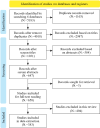Assessment of ambulation functions through kinematic analysis in individuals with stroke: a systematic review
- PMID: 40008910
- PMCID: PMC11920755
- DOI: 10.23736/S1973-9087.25.08767-2
Assessment of ambulation functions through kinematic analysis in individuals with stroke: a systematic review
Abstract
Introduction: Although kinematic assessments for stroke-induced lower limb impairments offer a promising alternative to conventional scale evaluations, interpreting high-dimensional kinematic data remains challenging due to numerous metrics reported in past studies. This study aimed to provide an exhaustive overview of existing studies using kinematics data to assess the gait impairments in individuals with stroke, along with examining their clinimetric properties for future clinical applications.
Evidence acquisition: A systematic search was conducted across PubMed (08/2024), Scopus (08/2024), Web of Science (08/2024), CINAHL (08/2024), EMBASE (08/2024), and IEEE (08/2024). We included articles that recruited individuals over 18 years old with stroke and utilized motion capture technologies to evaluate lower limb kinematics. Similar metrics were consolidated in the analysis, and the COSMIN Risk of Bias Checklist was used to evaluate the methodological quality of studies investigating the clinimetric properties of kinematic metrics. Convergent validity of metrics was evaluated by examining their association with the Fugl-Meyer scale of lower limbs and walking speed. Moreover, the GRADE approach was used to rate the quality of evidence.
Evidence synthesis: A total of 383 studies were classified into 10 categories. Seven studies on metric reliability were rated high for methodological quality. Metrics with satisfactory reliability included spatiotemporal, spatial metrics, and a data-driven score. Six studies with high methodological quality assessed convergent validity. The dynamic gait index, angular component of the coefficient of correspondence (ACC), change in cadence, stride length, and hip range of motion showed satisfactory validity. Among the 13 studies, 12 studies were rated as moderate quality of evidence using the GRADE approach.
Conclusions: There are significant variations in measurements across studies, and high-quality studies evaluating clinimetric properties are scarce. For a more standardized evidence-based approach to kinematic lower limb assessment, further high-quality research validating these assessments' clinimetric properties is essential.
Conflict of interest statement
Figures
Similar articles
-
Systematic Review on Kinematic Assessments of Upper Limb Movements After Stroke.Stroke. 2019 Mar;50(3):718-727. doi: 10.1161/STROKEAHA.118.023531. Stroke. 2019. PMID: 30776997
-
Effectiveness of an ankle-foot orthosis on walking in patients with stroke: a systematic review and meta-analysis.Sci Rep. 2021 Aug 5;11(1):15879. doi: 10.1038/s41598-021-95449-x. Sci Rep. 2021. PMID: 34354172 Free PMC article.
-
Touchscreen-based assessment of upper limb kinematics after stroke: Reliability, validity and sensitivity to motor impairment.J Neuroeng Rehabil. 2025 Feb 11;22(1):27. doi: 10.1186/s12984-025-01563-6. J Neuroeng Rehabil. 2025. PMID: 39934877 Free PMC article.
-
Psychometric properties of wearable technologies to assess post-stroke gait parameters: A systematic review.Gait Posture. 2024 Sep;113:543-552. doi: 10.1016/j.gaitpost.2024.08.004. Epub 2024 Aug 8. Gait Posture. 2024. PMID: 39178597
-
Implications of neuromuscular electrical stimulation on gait ability, balance and kinematic parameters after stroke: a systematic review and meta-analysis.J Neuroeng Rehabil. 2024 Sep 18;21(1):164. doi: 10.1186/s12984-024-01462-2. J Neuroeng Rehabil. 2024. PMID: 39294678 Free PMC article.
Cited by
-
Kinematic Biomarkers of Limb Shortening and Compensations in Hemiparetic Gait: A Systematic Review.Sensors (Basel). 2025 Jul 25;25(15):4598. doi: 10.3390/s25154598. Sensors (Basel). 2025. PMID: 40807764 Free PMC article. Review.
References
-
- Arene N, Hidler J. Understanding motor impairment in the paretic lower limb after a stroke: a review of the literature. Top Stroke Rehabil 2009;16:346–56. https://www.ncbi.nlm.nih.gov/entrez/query.fcgi?cmd=Retrieve&db=PubMed&l... 10.1310/tsr1605-346 - DOI - PubMed
-
- Gray V, Rice CL, Garland SJ. Factors that influence muscle weakness following stroke and their clinical implications: a critical review. Physiother Can 2012;64:415–26. https://www.ncbi.nlm.nih.gov/entrez/query.fcgi?cmd=Retrieve&db=PubMed&l... 10.3138/ptc.2011-03 - DOI - PMC - PubMed
-
- Balaban B, Tok F. Gait disturbances in patients with stroke. PM R 2014;6:635–42. https://www.ncbi.nlm.nih.gov/entrez/query.fcgi?cmd=Retrieve&db=PubMed&l... 10.1016/j.pmrj.2013.12.017 - DOI - PubMed
-
- Tyson SF, Hanley M, Chillala J, Selley A, Tallis RC. Balance disability after stroke. Phys Ther 2006;86:30–8. https://www.ncbi.nlm.nih.gov/entrez/query.fcgi?cmd=Retrieve&db=PubMed&l... 10.1093/ptj/86.1.30 - DOI - PubMed
-
- Reisman DS, Scholz JP. Aspects of joint coordination are preserved during pointing in persons with post-stroke hemiparesis. Brain 2003;126:2510–27. https://www.ncbi.nlm.nih.gov/entrez/query.fcgi?cmd=Retrieve&db=PubMed&l... 10.1093/brain/awg246 - DOI - PubMed
Publication types
MeSH terms
LinkOut - more resources
Full Text Sources
Medical
Miscellaneous






